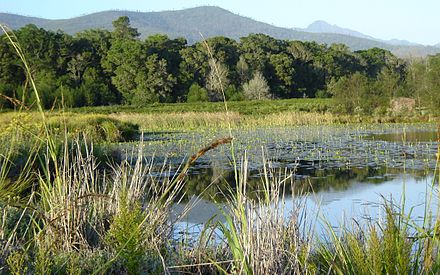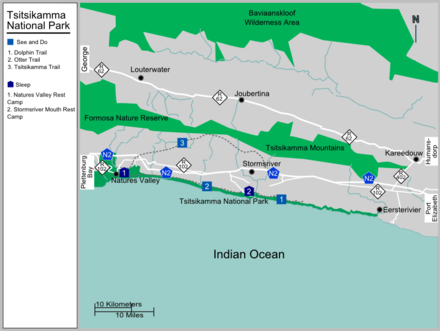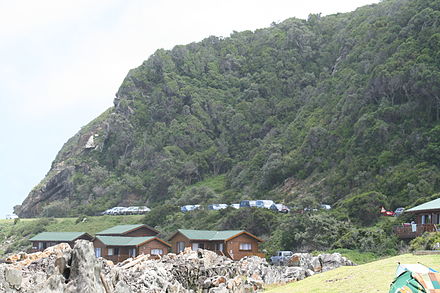Tsitsikamma National Park - former national parkin South Africa
The Tsitsikamma National Park, a section of the Garden Route National Park, is situated in the heart of the famous Garden Route in South Africa. The park offers some fine coastal scenery and sometimes the option of whale-watching.

Tsitsikamma
Tsitsikamma is a Khoisan (early inhabitants of the area) word meaning, "place of much water." They probably referred to the average annual rainfall of 1200 mm.
Understand
The Tsitsikamma Park is one of the most visited in South Africa, because of the pleasant climate, the beauty of the scenery, the wealth of things to do and see, and also because environmental travellers enjoy the wilderness and the biodiversity.
History
The area has a very interesting political, social and environmental history. Palaeontological evidence abounds of the prehistoric hominins who peopled the coastline. Archeological digs at Plettenberg Bay's Robberg and rock art in the De Vasselot section of the Tsitsikamma National Park indicate that earlier people were what are called strandlopers in South Africa, or beachcombers. By the time European traders and colonisers arrived, in mid-1600s, the people of the Cape were mainly Khoisan and Bantu peoples.
In the 18th century the port town of Knysna became a center of timber trade, which precipitated a woodcutter period of deforestation that saw some of the oldest trees in the forest, especially the yellowwoods, cut down. The forest suffered less damage than might be expected, since the woodcutters were selective about trees, leaving the forest canopy intact, and allowing the saplings to survive.
As the area developed forested areas were occasionally cleared to make way for plantations of exotic trees like pine. Initially the Reserve formed part of the wild Tsitsikamma forest. It was privately owned at the time when South Africa proclaimed the area a protected National Park, and for several decades served as farmland for potatoes and pine plantations. The soil became degraded and the forested parts on Platbos started to dwindle. However, in the late 1990s the property was bought by an environmentally-minded family determined to attempt forest rehabilitation. Thus it became Platbos Reserve.
Landscape

Many factors play a role in the shrinking of the forest, including climate change over millennia which favoured savannah grassland and fynbos vegetation to weather the arid climate. The Tsitsikamma rainforest survives on a fraction of the precipitation the world's other temperate rainforests need. Deforestation and the introduction of exotic plants by colonialists also placed the forests under pressure. Even now, while the forests of South Africa's Garden Route are protected parks, exotic plants like the Blue Gum and Australian wattles continue to consume most of the water in the soil and, growing much faster, crowd out indigenous species.
Also, the pioneer vegetation of the Tsitsikamma forest is Cape fynbos, which consists of obligate seeders and which needs fire to germinate. Since the trees in the Tsitsikamma forest lose their lower branches as they reach the forest canopy, the forest is largely fire resistant. Fire, however, endangers the young trees on the forest edges. If this forest nursery burns down with every fynbos fire, the forest cannot advance.
Forest rehabilitation is therefore a long-term project that is very labour-intensive. It involves firstly attending to the health of existing forest by clearing it of invasive plant species. Secondly, pioneer and nurse vegetation must be planted or protected. These plants on the edge of the forest prepare the soil for saplings, and faster growing indigenous trees, like the keurboom, offer saplings shade under which they flourish. The forest nursery should also be protected from the Western Cape's aggressive fires, by maintaining firebreaks.
Flora and fauna
The Tsitsikamma forest is an ecological wonderland. It can alternately be describes as a coastal temperate rainforest or an Afromontane forest. The forest on Platbos Reserve includes many if not all of the special species of tree found here, such as Real Yellowwood (Podocarpus latifolius), Outeniqua Yellowwood (Podocarpus falcatus), and Stinkwood (Ocotea bullata). It is beautiful inside the forest, as if you are inside a cathedral. Sounds are muted, and the call of the birds are clear and simply enchanting. The forest canopy lets through dappled light, but keeps the air moist enough to smell of earth and humus. It is this forest that is so difficult to rehabilitate. It can take hundreds of years for the forest edge to advance only meters. The fynbos prepares the way for a nurse population of trees (such as Virgilia divaricata, or Cape lilac). Only under the shelter of these fast growing trees will the trees that characterise Tsitsikamma forest grow at all.
The meadows of fynbos look and feel completely different. Fynbos consists of low shrubbery, and what makes it so special is the variety of flowers and colours. Fynbos's most wonderful attribute is the spicy, woody fragrance. In a fynbos field like this the air is full of the smell.
Platbos Reserve is home to several bush and forest mammals, such as the shy bushpig (Potamochoerus larvatus), caracal (caracal), Chacma baboon (Papio ursinus), bushbuck (scriptus) and many more.
The forest and the open fields hosts a vast variety of different bird species. If you are a bird watcher you will enjoy the exquisite and very rare tauraco, which is popularly known as the Knysna lourie (Tauraco corythaix) in the forest, and several species of colourful sunbird in the fynbos.
Since it is a wilderness area snakes, spiders and insects are also plentiful.
Climate
Although the forest is called a temperate rainforest, it manages to survive on very little rain. The rainfall is approximately 945 mm per annum. This is very low compared to other temperate rainforests, such as in the Great Smoky Mountains National Park in North America which has annual precipitation of 200-400 cm. The summer, especially January and December, is the rainy season. Rainy weather varies from persistent drizzle and misty days, to storms and cloudbreaks. The wettest months are May and October, and the driest are June and July.
The temperature ranges between 23°C/17°C in January and 17°C/10°C in July. The fact that the Reserve is on the coast of the warm Indian ocean explains the balmy climate.
Get in
By car
Simply follow the N2 and use the exit to Tsitsikamma National Park/ Stormsriver Mouth, 5 km west of Storms River. Located just off the N2, on the R102, the Reserve is easily accessible by car. It takes about 3 hours to drive there from Port Elizabeth, and around 6 hours from Cape Town. The closest airports are in Port Elizabeth (201 km away) and George (130 km away).
By bus
The main bus companies as well as the Baz bus stop at the Total Petroport on the N2 next to the Paul Sauer bridge over the Storms River. This is about 15 km away from the Storms River Mouth entrance and 55 km from Nature's Valley entrance, but it is generally easy to hitch a lift from there. There is a Tsitsikamma information centre, curio shop, restaurant and fast-food outlet at the Petroport, as well as spectacular views over the Storms River Gorge. Not the worst place to get stuck for a short while when trying to hitch a ride.
Fees


Tsitsikamma Section fees (valid until 31 October 2022):
- South African citizens and residents (with ID): R60 per adult, R24 per child, per day
- SADC Nationals (with passport): R120 per adult, R49 per child, per day
- Foreign visitors: R272 per adult, R98 per child, per day
- Storms River Mouth Rest Camp. South African Citizens and Residents (with ID) pay R28 per person, per day. SADC Nationals (with passport) pay R50 per adult, per day (children R28). The Standard Conservation Fee for Foreign Visitors: R88 per adult and R44 per child, per day.
- Nature's Valley's Restcamp. South African Citizens and Residents (with ID) and SADC Nationals (with passport) pay R22 per day. The Standard Conservation Fee for Foreign Visitors: R44 per adult and R22 per child, per day.
Get around
By foot only. See Do section.
See
- Nature
- Storms River suspension bridge - The forest walkway to the bridge has been upgraded and 2 additional smaller suspension bridges have been added, part of the walkway to/from the main suspension forms circular forms a circular route.
Do
- Go diving
- Spirit of Tsitsikamma, +27 42 281-1607. Eco-friendly boat cruise up the Storms River Gorge.
Short hikes
Short hikes (no fees or permits needed other than entrance fee):
- Mouth Trail. 1 km, a linear route. Walk from the park's restaurant to the suspension bridge, the key feature of the Tsitsikamma National Park, a long free-hanging bridge. It can often be seen on photographs, advertising the Tsitsikamma.
- Viewpoint Trail. Walk past the Suspension Bridge, 2 km, linear route. The first part is a pretty steep climb, towards the viewpoint it becomes a more gentle slope. You get a nice view of the Indian Ocean, the mouth, the bridge and the restcamp.
- Waterfall Trail. First half day hike of the famous Otter trail, starting at the Oceannettes on the eastern side of the restcamp. 6.4 km to the waterfall and back, just over 3 hours (a linear route). The latest starting time in summer 2:30PM and in winter 1:30PM. The hike is marked as difficult, due to uneven and slippery terrain. Take along your swimming gear for a refreshing dive under the waterfall, which marks the half way point.
- Loerie Trail. Starts a little bit east of the restaurant, a small walk past a viewpoint, offering only ocean views. 1.5 km and circular. 2021-05-16
- Blue Duiker Trail. 5.5 km and circular. It starts along the Loerie Trail, later turns towards the coastline, following the Waterfall Trail back to the Oceannettes.
Multi-day hikes
- Otter Trail. 42 km, 5 days and 4 nights with good overnight huts. You have to book ahead. Bookings can be taken a year in advance, which means that there are often last minute cancellations, so it's always worth seeing if you can get in at the last minute. Bring your own food and sleeping bags. You do not need tents. You need to be fairly fit as the trail follows the cliffs and hills along the coastline, dipping down to the rivers. What goes down must come up. It's beautiful and only 12 people are allowed on any one part of the hike, so it really is unspoilt and worth doing. Be prepared for a difficult river crossing on day three. Please check with the parks officials when low tide is and ask for advice on getting over the river. R685pp
- Dolphin Trail. 20 km, 2 days and 3 nights. Fully catered accommodation in luxury lodges. From R8,000pps 2020-11-21
- Tsitsikamma Trail, +27 42 2811-712, gpi@mto.co.za. Hike from Nature's Valley through the Tsitsikamma Mountains to Storms River. You can choose to walk 2 to 6 days, with or without porterage. If you want to walk just a section, just a day, it appears to be possible as well. From R200 per person per day, without porterage, but including overnight huts
Buy
At Stormsriver Restcamp, the Park's Shop offers the basic needs and souvenirs. In Nature's Valley's Restcamp is no restaurant or shop.
Eat
There is a restaurant Cattle Baron and bar only at the Stormsriver Restcamp.
Drink
Get your drinks at the shop (closes at 6PM), or at the bar of the restaurant (closes after the last guest left, somewhere between 7PM and 10PM). Getting drinks after hours, you need to drive out of the park (gate is manned 24 hours). Either to Sugars Tavern in Stormriver West (township) or Dolfy's Tavern, next the N2 300 m past the petrol station/Paul Sauer Bridge, on your right hand side, both are open till 10PM on weekdays and 2AM in weekends (Friday and Saturday).
Sleep
 There are two camps in the park. Be sure to book accommodation before you arrive, especially during high-season. You can check in from noon, check out is till 9AM.
There are two camps in the park. Be sure to book accommodation before you arrive, especially during high-season. You can check in from noon, check out is till 9AM.
- Storms River Mouth Rest Camp, +27 44 281-1607, reservations@sanparks.org. The bigger of the two with more facilities.
- Camping with/without power point: R220 (2 persons, maximum 6 persons, additional rate per person R48)
- Camping with power point and view: R250 (2 persons, maximum 6 persons, additional rate per person R48)
- Forest Hut with communal facilities: R340 (2 persons)
- Forest Cabin with communal kitchen: R620 (2 persons)
- Chalet: R660-R715 (2 persons, maximum 3 or 4 persons, additional rate per person R144)
- Honeymoon Cottage: R900 (2 persons)
- Family Cottage: R1095 (4 persons)
- Oceanette: R620 (2 persons, maximum 3 persons, additional rate per person R144)
- Oceanette Large: R1095 (4 persons)
- Guest Cottage: R2195 (4 persons, maximum 8 persons, additional rate per person R248
- Nature's Valley Restcamp, +27 44 531-6700, reservations@sanparks.org. Camping without power point: R150 (2 persons, maximum 6 persons, additional rate per person R48). Forest Hut with communal facilities: R335 (2 persons). From R150
- Tranquility Lodge, +27 44 531-6663, book@tranquilitylodge.co.za. Peace and luxury surrounded by mountains and a pristine beach. The garden hosts a unique hot-pool.
Stay safe
Go next
- The rest of the Tsitsikamma
- The Garden Route
- Jeffreys Bay - the surfer's paradise to the east of the Tsitsikamma.
- Plettenberg Bay - A beautiful and vibrant coastal town where many boutique shops, galleries and ocean adventures can be had.
- Nature's Valley - A quaint seaside village which boasts several kilometers of pristine beach, coastal and forest hikes, a lagoon and a local pub restaurant.
- The Crags - A tourist destination that is home to an elephant sanctuary, a winery, and several other destinations.
Related: Diving the Tsitsikamma
Related: African National Parks
Related: African flora and fauna
